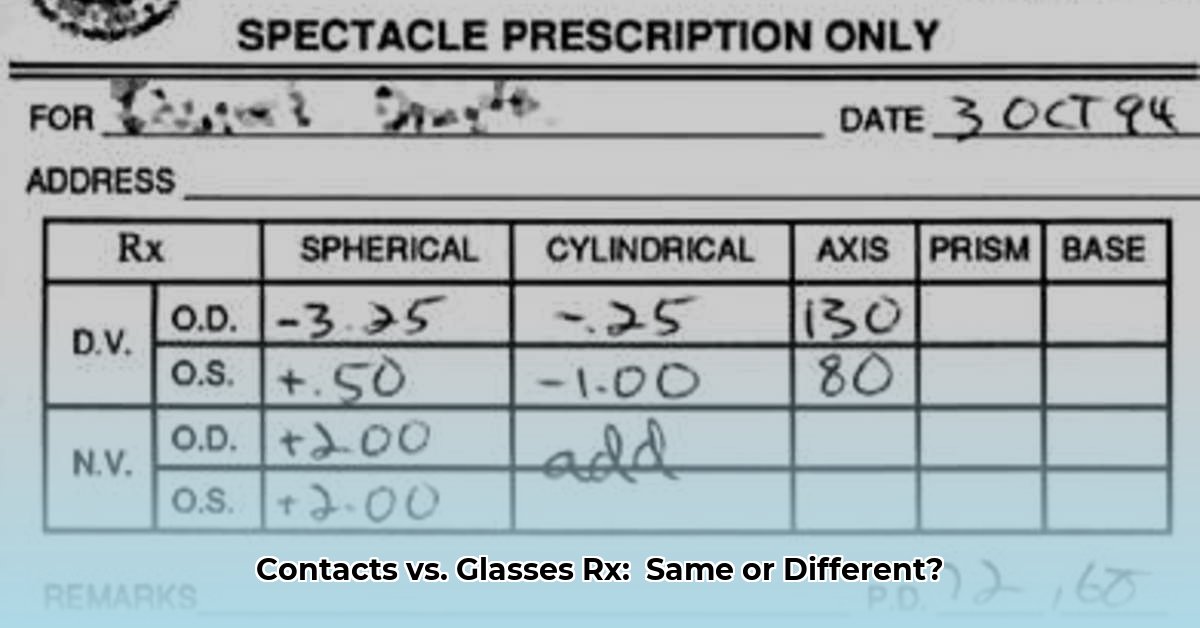Why Your Glasses and Contacts Need Different Prescriptions
Ever wonder if your eyeglass prescription could double as a contact lens prescription? It’s a common question, and the answer is a resounding no. While both correct vision, they do so from different distances, requiring distinct prescriptions. Think of it like using a map designed for driving versus one for hiking—both guide you, but the details and perspectives differ greatly depending on your proximity to the terrain.
The 12mm Divide: A Tale of Two Prescriptions
The key difference boils down to a seemingly small distance: about 12 millimeters. That’s roughly the space between your eyeglasses and your eyes. Contact lenses, however, sit directly on your cornea, eliminating that gap. This seemingly insignificant 12mm dramatically affects the lens power needed for clear vision. Imagine adjusting a magnifying glass—a slight shift in distance significantly impacts focus. Similarly, the 12mm gap changes how light enters your eye, requiring different corrective powers for glasses and contacts.
Decoding Your Prescriptions
Both eyeglass and contact lens prescriptions contain familiar elements like:
- Sphere (SPH): Corrects nearsightedness (myopia) or farsightedness (hyperopia).
- Cylinder (CYL) and Axis: Correct astigmatism, an imperfection in the eye’s curvature.
- Add: Provides magnification for near vision, often used in bifocals or reading glasses.
However, contact lens prescriptions include crucial additional parameters:
- Base Curve (BC): Measures the curvature of the lens’s back surface, like the shape of a bowl. It ensures a snug yet comfortable fit against your cornea.
- Diameter (DIA): Specifies the lens width, ensuring complete coverage of your iris.
Eyeglass prescriptions, on the other hand, include your Pupillary Distance (PD), the distance between your pupils, which is essential for aligning eyeglass lenses.
Here’s a handy table summarizing the key differences:
| Feature | Eyeglasses | Contact Lenses |
|---|---|---|
| Sphere (SPH) | Corrects nearsightedness/farsightedness | Corrects nearsightedness/farsightedness |
| Cylinder (CYL) | Corrects astigmatism | Corrects astigmatism |
| Axis | Angle of astigmatism correction | Angle of astigmatism correction |
| Add | Reading magnification | Reading magnification |
| Pupillary Distance (PD) | Crucial for aligning lenses in eyeglasses | Sometimes included for multifocal contacts |
| Base Curve (BC) | Not Applicable | Essential for lens curvature to match your eye |
| Diameter (DIA) | Not Applicable | Essential for lens width to fit your eye |
| Lens Material | Not Applicable | Crucial for comfort, oxygen permeability, and eye health |
Why You Can’t Use Your Eyeglass Prescription for Contacts
Using your eyeglass prescription for contact lenses is a no-go. It’s like trying to use a house key to unlock your car—the wrong tool for the job. The missing BC and DIA measurements are essential for a proper contact lens fit. An incorrect fit can lead to discomfort, blurry vision, and potentially even eye health issues due to reduced oxygen flow to the cornea.
Beyond the Basics: Material, Brand, and Expiration
Contact lens prescriptions also specify lens material (e.g., silicone hydrogel) and often the brand. Different materials offer varying levels of oxygen permeability (how well oxygen passes through the lens), impacting eye health and comfort. Like clothing fabrics, some materials suit certain individuals better than others. Furthermore, most contact lens prescriptions expire annually. This is because our eyes can change over time, just like the rest of our bodies. Regular checkups are essential to ensure your prescription remains accurate and your eyes stay healthy.
Choosing the Right Vision Correction: Glasses, Contacts, or Both?
The best vision correction method depends on individual needs and preferences. Glasses offer convenience and a wider range of styles, while contacts provide a more natural field of vision and are ideal for activities like sports. Many people opt for both, enjoying the flexibility of switching between them.
High Power and Astigmatism: Why Precision Matters
For those with higher prescriptions or significant astigmatism, the difference between glasses and contact lens prescriptions becomes even more critical. The closer proximity of contacts to the eye requires a more refined and personalized fit for optimal vision. Current research suggests that personalized contact lens designs based on detailed eye mapping may offer even more precise vision correction in the future.
Next Steps: See Your Eye Doctor
Don’t gamble with your eye health. Schedule a comprehensive eye exam with a qualified optometrist or ophthalmologist. They’ll perform the necessary measurements, evaluate your eye health, and recommend the best vision correction strategy for your unique needs, whether it’s eyeglasses, contact lenses, or other options like LASIK surgery. Remember, clear and comfortable vision is achievable with the right approach, so take the first step towards better eye health today.
- Bento Box Glass Offers Practical, Eco-Friendly Meal Storage - December 16, 2025
- The Best Bento Box Price For Your Perfect Packed Lunch - December 15, 2025
- Bento Box Shopping Tips for Smart and Stylish Lunch Prep - December 14, 2025










